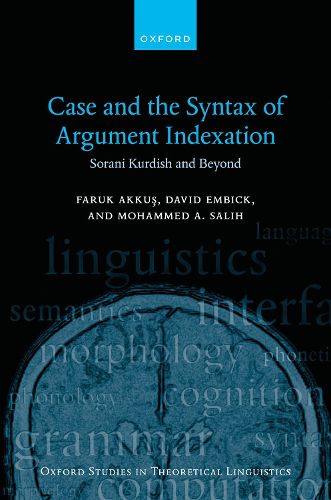Readings Newsletter
Become a Readings Member to make your shopping experience even easier.
Sign in or sign up for free!
You’re not far away from qualifying for FREE standard shipping within Australia
You’ve qualified for FREE standard shipping within Australia
The cart is loading…






This book presents an analysis of argument indexation, the process by which arguments in a clause are coindexed with grammatical markers that bear their features. The main case study is based on varieties of Sorani Kurdish (in the Iranian language family), whose indexation properties interact with an alignment split of the type often called 'split Ergative.' From this, the authors develop a more general theory that can be applied to many other languages. A key line of argument is that agreement and clitic movement operations target specific cases, in a process called 'Case Targeting'. The approach further hypothesizes that case labels like 'Nominative', 'Ergative', and so on are shorthand for decomposed feature bundles. It is these features that are targeted by syntactic operations (agreement and movement). In addition to requiring Case Targeting, the analysis of Sorani implies that syntactic operations (agreement, clitic movement) and their morphophonological reflexes may be mismatched: agreement and movement can both produce affixes and clitics, contrary to many views of morphosyntax/morphophonology relations. The book offers a detailed exploration of the implications of this approach, particularly for theories of case assignment.
$9.00 standard shipping within Australia
FREE standard shipping within Australia for orders over $100.00
Express & International shipping calculated at checkout
This book presents an analysis of argument indexation, the process by which arguments in a clause are coindexed with grammatical markers that bear their features. The main case study is based on varieties of Sorani Kurdish (in the Iranian language family), whose indexation properties interact with an alignment split of the type often called 'split Ergative.' From this, the authors develop a more general theory that can be applied to many other languages. A key line of argument is that agreement and clitic movement operations target specific cases, in a process called 'Case Targeting'. The approach further hypothesizes that case labels like 'Nominative', 'Ergative', and so on are shorthand for decomposed feature bundles. It is these features that are targeted by syntactic operations (agreement and movement). In addition to requiring Case Targeting, the analysis of Sorani implies that syntactic operations (agreement, clitic movement) and their morphophonological reflexes may be mismatched: agreement and movement can both produce affixes and clitics, contrary to many views of morphosyntax/morphophonology relations. The book offers a detailed exploration of the implications of this approach, particularly for theories of case assignment.